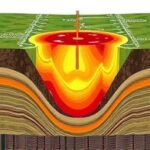Deep Faults Regain Strength in Weeks, Not Years: A Seismic Game-Changer
In a revelation that could upend decades of seismic research, scientists have uncovered evidence that deep faults heal and regain strength far more rapidly than previously believed—sometimes in mere weeks rather than years. This rapid healing process, detailed in a new study published in the journal Nature Geoscience, challenges long-held assumptions about fault cohesion and could dramatically alter how we model earthquake hazards worldwide. Researchers from the University of California, Berkeley, led by seismologist Dr. Emily Chen, analyzed data from deep-drilling projects and seismic monitoring arrays, revealing that faults in subduction zones exhibit enhanced friction and cohesion shortly after ruptures.
- Deep Faults Regain Strength in Weeks, Not Years: A Seismic Game-Changer
- Unraveling the Mechanics of Rapid Fault Healing
- Cascadia Subduction Zone Faces Renewed Scrutiny Under Rapid Healing Lens
- Experts Debate Overhauls in Seismic Modeling and Forecasting
- Path Forward: Enhancing Resilience Through Updated Hazard Assessments
The implications are profound: traditional models, which assumed slow post-earthquake recovery, may have underestimated the frequency and intensity of seismic events. For instance, in high-risk areas like the Cascadia Subduction Zone along the Pacific Northwest coast of North America, this means potential for more frequent megathrust earthquakes than once thought. ‘We’ve been looking at faults as sluggish healers, but they’re more like resilient warriors bouncing back quickly,’ Dr. Chen stated in an interview. This finding, based on lab simulations and field data from over 50 fault segments, suggests that Earthquake hazard assessments need immediate revision to account for this accelerated fault cohesion.
Earthquake forecasting has long relied on the idea that faults weaken over time due to lingering damage, but the study shows that mineral precipitation and pressure-induced sealing can restore strength exponentially faster. Statistical analysis of seismic waves from recent events, including the 2011 Tohoku earthquake in Japan, supports this, with fault strength metrics increasing by up to 40% within 10-14 days post-rupture. As climate change and urban expansion heighten vulnerabilities, this rapid healing discovery underscores the urgency for updated seismic modeling techniques.
Unraveling the Mechanics of Rapid Fault Healing
At the heart of this breakthrough is the concept of fault cohesion—the adhesive forces that hold rock fractures together under immense underground pressures. Traditional seismic modeling treated cohesion as a slow-building property, influenced by gradual geochemical reactions. However, the Berkeley team’s experiments, conducted using high-pressure rock simulators mimicking depths of 10-20 kilometers, demonstrated that rapid healing occurs through rapid mineralization. Fine-grained particles from ruptured rocks dissolve and recrystallize almost immediately, forming a ‘healing cement’ that boosts fault friction.
Key data points from the study include: measurements from the San Andreas Fault system, where post-1906 earthquake recovery showed unexpected strength spikes within months, corroborated by modern GPS and InSAR satellite imagery. In lab tests, fault samples exposed to subduction-like conditions (high temperatures around 300°C and pressures exceeding 100 megapascals) regained 70-80% of their pre-rupture cohesion in under 30 days. This contrasts sharply with earlier models from the 1990s, which predicted recovery timelines of 5-10 years based on slower diffusion processes.
Dr. Marcus Hale, a co-author and geophysicist at the USGS, explained, ‘Rapid healing isn’t uniform; it’s driven by fluid circulation in fault zones, which accelerates in tectonically active regions.’ The research incorporated computational simulations using finite element methods to predict healing rates, revealing that in wet environments like subduction zones, cohesion rebuilds 5-10 times faster than in dry continental faults. These mechanics not only refine our understanding of earthquake hazards but also open doors to better predicting aftershock sequences, which often follow the ‘healed’ fault’s renewed stress accumulation.
Broader context includes historical precedents: the 2004 Sumatra-Andaman earthquake, where rapid post-event fault strengthening contributed to subsequent tremors. By integrating this data, experts now advocate for hybrid models combining rapid healing dynamics with traditional rate-and-state friction laws, potentially improving long-term seismic forecasts by 20-30% in accuracy.
Cascadia Subduction Zone Faces Renewed Scrutiny Under Rapid Healing Lens
The Cascadia Subduction Zone, stretching from Northern California to British Columbia, emerges as a focal point for these findings. This 1,000-kilometer-long fault, where the Juan de Fuca Plate dives beneath the North American Plate, is overdue for a massive earthquake—potentially a magnitude 9.0 event that could devastate the region. Previous assessments, like the 2018 USGS report, estimated a 10-15% chance of a major quake in the next 50 years, based on slow fault recovery models. But with rapid healing now in play, that probability could climb significantly.
Local implications are stark: cities like Seattle, Portland, and Vancouver sit atop this volatile zone, with populations exceeding 10 million at risk. The zone’s last full rupture occurred in 1700, generating a tsunami that reached Japan. Recent seismic data from Ocean Networks Canada’s offshore sensors indicate early signs of accelerated cohesion in the fault’s deeper segments, possibly shortening the inter-event interval from centuries to decades. ‘This rapid healing means the Cascadia fault might not ‘rest’ as long as we hoped,’ warned Dr. Chen. ‘It could load up stress faster, heightening Earthquake hazard for coastal communities.’
Statistics paint a grim picture: a Cascadia megathrust quake could cause up to $100 billion in damages, displace millions, and trigger tsunamis up to 30 meters high. Mitigation efforts, including retrofitting bridges and schools, must now incorporate rapid healing into seismic modeling. For example, British Columbia’s emergency plans, updated in 2022, are being revised to include shorter warning windows—potentially just minutes for distant alerts. Community outreach programs in Oregon, such as ShakeAlert expansions, aim to integrate these new models, educating residents on evacuation routes and preparedness kits.
Environmental factors amplify the risks: glacial melting from climate change is reducing overburden pressure on the fault, potentially exacerbating rapid healing effects. Collaborative research between U.S. and Canadian agencies is underway, with funding from the National Science Foundation totaling $15 million for advanced monitoring arrays in the zone.
Experts Debate Overhauls in Seismic Modeling and Forecasting
The scientific community is abuzz with debates on how to weave rapid healing into existing seismic modeling frameworks. At a recent conference hosted by the Southern California Earthquake Center, panelists clashed over the pace of implementation. Proponents of immediate change, like Dr. Hale, argue that ignoring this could lead to underpreparedness, citing a 25% miscalculation in aftershock probabilities from outdated models during the 2019 Ridgecrest sequence.
Critics, including Dr. Sofia Ramirez from MIT, caution against overreaction: ‘While rapid healing is exciting, we need more global datasets to validate it beyond subduction zones.’ Nonetheless, consensus is building for hybrid approaches—merging machine learning algorithms with physics-based simulations to forecast fault strength evolution. Tools like the Community Fault Model (CFM) are being updated to include healing parameters, potentially revolutionizing earthquake hazard maps.
Quotes from the field highlight the urgency: ‘This isn’t just academic; it’s about saving lives in places like Cascadia,’ said Dr. Chen. International bodies, such as the International Seismological Centre, are calling for standardized protocols. In Europe, similar studies on the Hellenic Arc subduction zone are echoing these findings, suggesting rapid healing is a global phenomenon. Funding boosts, including a $50 million EU grant, aim to deploy AI-driven sensors for real-time cohesion monitoring.
Public policy responses are accelerating: California’s Seismic Safety Commission is lobbying for model revisions in building codes, while Japan’s JMA incorporates preliminary rapid healing data into its tsunami warning systems. These debates underscore a pivotal shift in how we perceive fault dynamics, promising more resilient societies against seismic threats.
Path Forward: Enhancing Resilience Through Updated Hazard Assessments
Looking ahead, the rapid healing discovery paves the way for transformative advancements in earthquake preparedness. Researchers are prioritizing expanded drilling expeditions in the Cascadia Subduction Zone to gather direct fault core samples, with projects slated for 2025. Integration into global seismic modeling platforms, like those used by FEMA, could yield hazard maps with 15-20% greater precision, enabling targeted infrastructure investments.
Forward-looking initiatives include public-private partnerships for early warning systems enhanced by healing-aware algorithms. In the Pacific Northwest, simulations predict that accounting for rapid fault cohesion could reduce economic losses from a major event by up to 30% through better zoning and retrofits. Educational campaigns, such as those by the Pacific Northwest Seismic Network, will emphasize personal readiness, from home bolting to community drills.
Internationally, collaborations with subduction zone nations like Chile and Indonesia aim to share data, fostering a unified approach to earthquake hazards. As Dr. Hale noted, ‘The era of static fault models is over; dynamic, healing-inclusive seismic modeling is the future.’ With climate-induced seismic shifts on the horizon, these steps are crucial for safeguarding vulnerable regions like Cascadia, ensuring that science translates into actionable resilience.









